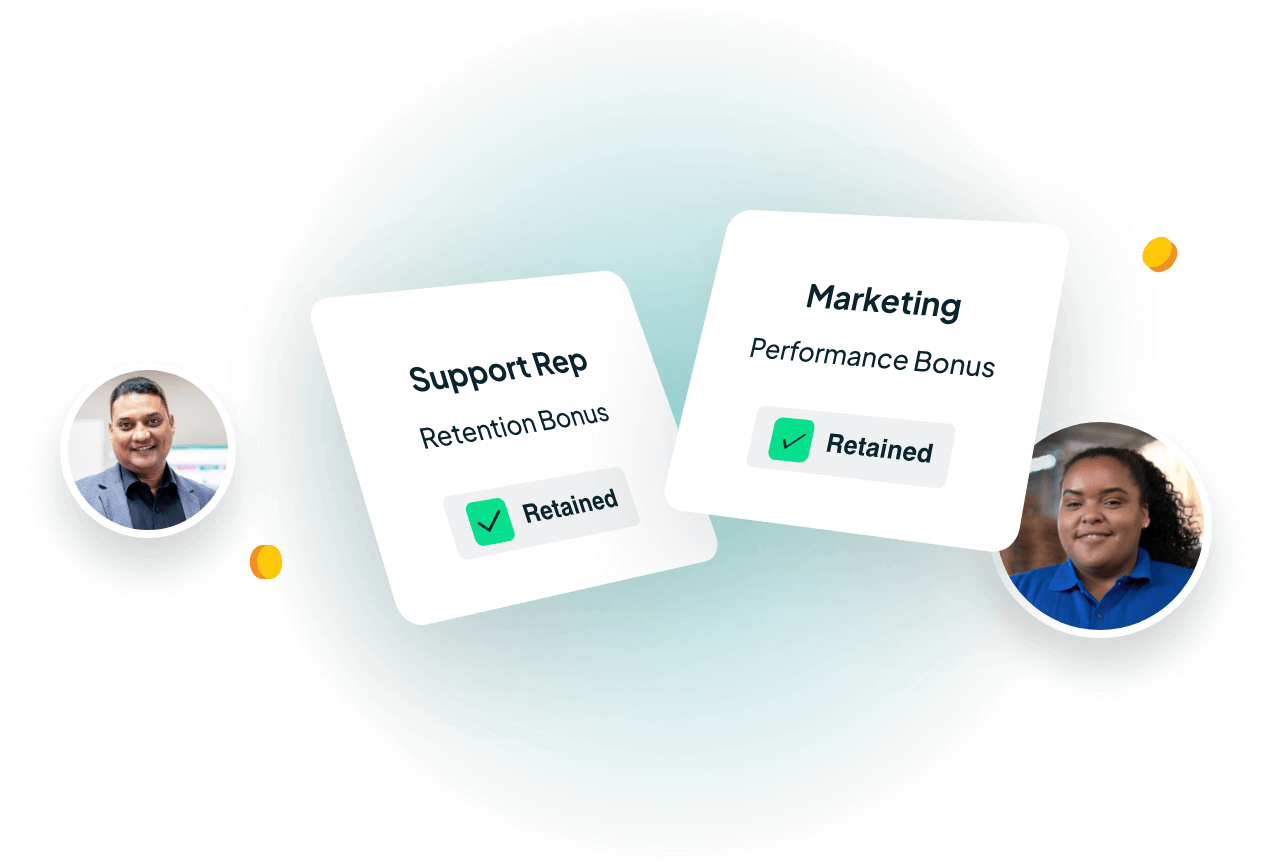-
Why Keep?
Why Keep
-
Employers
-
Employees
-
- Solutions
- Resources
- About Us
The Ultimate Guide to Employee Bonus Structures
Table of Contents
- The Ultimate Guide to Employee Bonus Structures (2023)
- What is an Employee Bonus Structure and Why is it Important to Employers and Employees Alike
- How Do You Set Up a Bonus Structure for Employees?
- What is a good bonus structure for employees?
- Understanding Different Types of Bonus Structures & Examples
- Creating an Effective Bonus Plan That Fits Your Organization’s Needs
- Considerations for Designing a Bonus Structure Plan
- Do bonus structures help with employee retention and engagement?
- Strategies for Implementing a New Employee Bonus Structure - How to determine bonuses for employees?
- Tips for Evaluating the Effectiveness of Your Employee Bonus Plan
- Keep Your Talent - With Vesting Cash Bonuses
The Ultimate Guide to Employee Bonus Structures
Managing a successful business often requires finding the right balance between rewarding employees who do great work and ensuring that finances remain in check. It’s not an easy task, but it is one of the most important factors to consider when creating employee bonus structures.
As an Finance leader, you understand more than anyone else how important it is to be thoughtful and deliberate when deciding on bonuses for your team. To provide some guidance and insight into how to effectively create employee bonus structures while keeping financials in mind, we have created this guide: The Ultimate Guide to Employee Bonus Structures.
Here you will find helpful tips that break down each area of the process including conducting cost surveys; setting performance expectations; tracking success; factoring draw against commission rates reward timing; outlining core responsibilities; communicating clear parameters for bonus eligibility, plus much more!
What is an Employee Bonus Structure and Why is it Important to Employers and Employees Alike?
An employee bonus structure is a vital element in the ecosystem of a thriving workplace.
Essentially, it serves as a strategic framework that employers can use to reward their workforce for meeting specific goals, excelling in their roles, or contributing towards overall organizational success. But why is it so crucial for both employers and employees alike? The answer lies in the balance this system strikes in fostering motivation, loyalty, and performance enhancement.
Employers benefit from a more motivated and committed workforce, with higher productivity and a willingness to go the extra mile for the company's objectives. Meanwhile, employees feel valued and appreciated, perceiving a direct correlation between their efforts and financial rewards.
In short, a well-designed employee bonus structure can act as the glue that binds people and organizations together, aligning interests and fostering a shared sense of purpose that ultimately paves the way for mutual success.
How Do You Set Up a Bonus Structure for Employees?
Designing an effective bonus structure for employees is an essential aspect of motivating and rewarding their hard work and dedication. The first step is to determine the objectives of the bonus program, whether it is to recognize individual performance, reinforce team collaboration or incentivize a specific desired behavior, such as retention.
A bonus structure should be aligned with the overall goals of the organization and remain flexible so that it can be modified as the company's needs and priorities shift. To ensure fairness and transparency, consider utilizing clearly defined criteria and performance indicators, while also taking into account qualitative factors like employees' contributions to company culture. Moreover, communicating the bonus structure criteria and performance expectations transparently and consistently helps build employee trust in the process.
Ultimately, a well-designed bonus structure should foster a positive and motivational work environment while driving employees to achieve both personal and organizational growth.
Setting up a bonus structure for employees involves several key steps. Here is an overview of the process:
- Determine the purpose of the bonus structure: The first step is to define the purpose of the bonus structure. Is it to reward individual performance, team performance, or company-wide performance? Understanding the purpose of the bonus structure will help you determine the appropriate criteria for eligibility and payouts.
- Establish clear and measurable goals: The bonus should be tied to specific goals that are measurable and achievable. These goals should be aligned with the overall goals and objectives of the company.
- Define the bonus formula: Once you have established clear and measurable goals, you need to determine the formula for calculating the bonus payout. This may involve a percentage of salary or a fixed dollar amount.
- Establish eligibility criteria: You need to establish clear criteria for determining eligibility for the bonus structure. This may include job performance, tenure, or other factors.
- Determine the payout frequency: The bonus structure may be paid out on a quarterly, bi-annual, or annual basis. It's important to determine the appropriate payout frequency based on the goals of the bonus and the financial resources of the company.
- Communicate the bonus: It's important to communicate the bonus structure clearly and transparently to employees. This includes explaining the criteria for eligibility, the formula for calculating payouts, and the payout frequency.
- Evaluate and adjust the bonus structure: The bonus should be evaluated regularly to determine its effectiveness in achieving the desired goals. Based on the results of the evaluation, adjustments may need to be made to the bonus structure to improve its effectiveness.
By following these steps, companies can set up a bonus structure that is fair, transparent, and aligned with their overall goals and objectives.
What is a Good Bonus Structure for Employees?
A well-designed and fitting bonus structure for employees can be the key to boosting motivation, job satisfaction, and overall productivity in the workplace. Delving into the world of performance bonuses, we find that there is no one-size-fits-all solution.
Various bonus structures cater to the diverse needs and preferences of employees – some prioritize individual performances, while others emphasize teamwork and collaboration. Profit-sharing and gain-sharing bonuses, for instance, aim to foster team spirit by distributing a percentage of the company's profits or gains among employees, augmenting their income by aligning personal success with organizational growth.
Alternatively, spot bonuses, awarded for exceptional individual performance, can inspire employees to go the extra mile in achieving their objectives.
Retention bonuses can further address issues of employee attrition by rewarding long-standing commitment to the company, promoting stability, and fostering a sense of belonging.
Understanding and selecting a suitable bonus structure depends upon an organization's unique context and its employees' needs, ultimately shaping a work environment that brings out the best in everyone.
Understanding Different Types of Bonus Structures & Examples
There are many different types of bonus structures that companies can use to incentivize and reward their employees. Here are some examples:
- Performance-based bonuses: These bonuses are tied to specific performance goals, such as meeting sales targets or achieving certain metrics. They can be paid out on a regular basis, such as quarterly or annually, or on an ad-hoc basis as goals are achieved.
- Profit-sharing bonuses: These bonuses are tied to the financial performance of the company and are typically paid out to all employees when the company reaches certain profit milestones.
- Sign-on bonuses: These bonuses are offered to new hires as an incentive to join the company. They are usually paid out once the employee has been with the company for a set period.
- Referral bonuses: These bonuses are offered to employees who refer successful job candidates to the company. The bonus is typically paid out once the new hire has been with the company for a set period.
- Spot bonuses: These are one-time bonuses given to employees for exceptional work or contributions to the company. They can be given at any time, without the need for a formal performance review or goal-setting process.
- Long-term incentive plans: These bonuses are designed to reward employees for their loyalty and long-term commitment to the company. They typically vest over several years and may be tied to the company's stock price or other financial metrics.
- Vesting cash bonuses: These bonuses are designed to reward employees for their loyalty and long-term commitment to the company. They provide the cash bonus to the employee up front, then vest over several years - helping employees hit their personal financial goals, immediately.
Bonus structures can be customized to suit the needs of individual companies and can be combined with other incentives, such as stock options or other equity-based compensation.
Creating an Effective Bonus Plan That Fits Your Organization’s Needs
Crafting an effective bonus plan tailored to your organization's needs is essential in fostering employee motivation, satisfaction, and ultimately, productivity. To achieve this, it is important to consider several factors that influence the impact of the bonus plan on your employees.
First determine the objectives of the plan, whether it is to increase overall team performance, individual achievements, or employee retention, and ensure that the bonus structure aligns with these goals. It is also crucial to establish eligibility criteria, performance measurements, and payout frequency that best suits your organization's dynamics.
When done correctly, a well-designed bonus plan can transform the workplace by reinforcing the desired behaviors, promoting employee engagement, and driving a strong performance-driven culture.
Considerations for Designing a Bonus Structure Plan
Designing a bonus structure plan is a crucial aspect of fostering employee retention and engagement within an organization. When well-crafted, bonus structures can significantly boost morale, productivity, and job satisfaction by recognizing the hard work and dedication of employees.
The cornerstone of an effective bonus plan is aligning the incentives with the organization's goals and values, ensuring that both employees and employers benefit from the system. Various factors, such as performance metrics, individual achievements, team accomplishments, and employee tenure, should be considered while formulating a rewarding bonus structure.
Ultimately, a transparent and consistent bonus plan that acknowledges outstanding efforts can serve as a powerful tool for motivating employees and fostering a sense of loyalty toward the organization.
When designing a bonus structure plan, there are several important considerations to keep in mind. Here are some key factors to consider:
- Alignment with company goals: The bonus structure should be aligned with the overall goals and objectives of the company. This means setting clear targets and metrics that align with the company's strategic plan.
- Fairness and equity: The bonus structure should be fair and equitable, with clear and transparent criteria for determining eligibility and payouts. It's important to avoid any perception of favoritism or bias.
- Motivation and engagement: The bonus structure should be designed to motivate and engage employees. This means setting challenging but achievable goals and offering meaningful rewards that are valued by employees.
- Cost and budget: The bonus structure should be designed to fit within the company's budget and financial resources. It's important to balance the cost of the bonus structure with the potential benefits in terms of increased employee engagement and retention.
Communication and transparency: The bonus structure should be communicated clearly and transparently to employees, with clear and concise explanations of the criteria for eligibility and payouts. - Compliance with regulations: The bonus structure should be compliant with all relevant laws and regulations, including tax laws and employment regulations.
- Flexibility: The bonus structure should be designed to be flexible and adaptable to changing circumstances, such as changes in the company's goals or market conditions.
By keeping these considerations in mind, companies can design bonus structures that are effective, fair, and aligned with their overall goals and objectives.
Do Bonus Structures Help With Employee Retention and Engagement?
Yes, bonus structures can help with employee retention and engagement. When employees feel that their hard work is being recognized and rewarded, they are more likely to be motivated and engaged. A well-designed bonus structure can also provide employees with a sense of security and stability, which can help to increase retention rates.
However, it's important to note that bonuses alone may not be enough to keep employees engaged and motivated. Companies should also focus on creating a positive work environment, offering opportunities for growth and development, and providing regular feedback and recognition to employees.
Additionally, it's important to ensure that the bonus structure is fair and transparent, with clear criteria for eligibility and payouts. If employees perceive the bonus structure to be unfair or biased, it can hurt retention and engagement.
Overall, bonus structures can be an effective tool for increasing employee retention and engagement, but they should be used in conjunction with other strategies to create a positive and supportive work environment.
Strategies for Implementing a New Employee Bonus Structure - How to Determine Bonuses for Employees
When it comes to implementing a new employee bonus structure, it is essential to establish a fair and motivating system that rewards dedicated individuals and encourages overall company growth.
There are a variety of methods to determine bonuses for employees, but the most effective strategies begin by setting clear performance targets and linking bonus payouts to measurable achievements. Evaluating each employee's contributions to both individual and team objectives allows for a merit-based structure that fosters healthy competition and continuous improvement.
Communication is key throughout this process; involving employees in target-setting discussions and providing transparent information about the bonus program helps promote trust and understanding within the organization. Periodic evaluations and adjustments to the bonus structure will ensure that it remains relevant and equitable as the company evolves.
In summary, a successful employee bonus structure hinges on clearly defined performance expectations, a strong focus on accountability, and open communication channels to promote employee engagement and satisfaction.
Tips for Evaluating the Effectiveness of Your Employee Bonus Plan
Evaluating the effectiveness of your employee bonus plan is an essential aspect of maintaining a motivated and thriving workforce. By regularly assessing its design and implementation, you can ensure that your bonus plan aligns with the company's objectives while providing value to your employees.
Key aspects to consider when assessing the effectiveness of your bonus plan include the overall cost, fairness, and measurable impact on productivity. Examining these components will help you determine if the bonus plan offers an equitable distribution of rewards and if it's driving the intended behavior or performance.
Monitoring employee satisfaction and soliciting feedback can also provide valuable insights into areas of improvement. Remember that a well-designed and evaluated bonus plan not only boosts employee morale but also supports the growth and success of your organization.
Keep Your Talent - With Vesting Cash Bonuses
In conclusion, Employee Bonus Structures are essential for employers and employees alike. They provide an incentive that boosts performance, while also rewarding loyal, hard-working employees. Setting up a bonus structure can be a daunting task but with the right plan and strategies in place, any HR and Finance team can create something that works best for their organization's needs.
It is important to consider how bonuses help with employee retention and engagement when designing the structure plan. Lastly, it is beneficial to regularly evaluate the effectiveness of your employee bonus plan to ensure it stays successful long-term. Understanding why bonuses are important and how to implement them can aid any organization in creating a successful Employee Bonus Structure.
By aligning the financial interests of employees with those of the company, Keep Financial's vesting cash bonus can create a sense of shared purpose and commitment that helps keep top talent on board.
To learn how Keep Financial can help you deliver valuable, flexible compensation that fits the needs of today’s workforce, schedule a demo today!
Get more insight.




